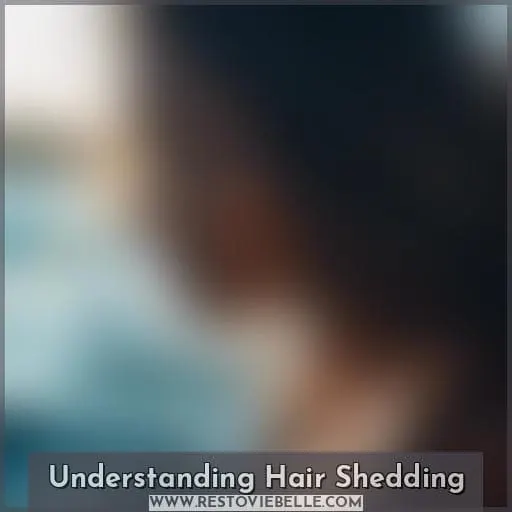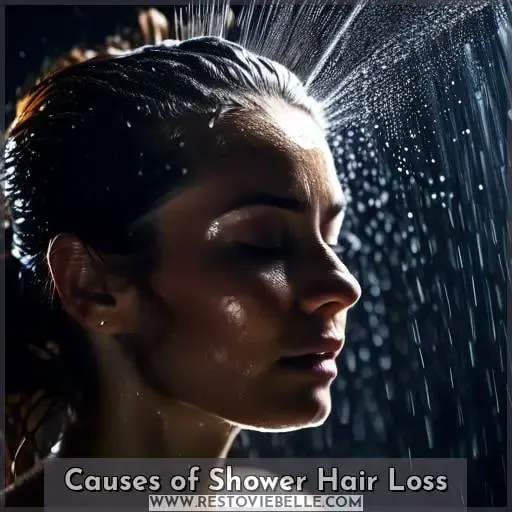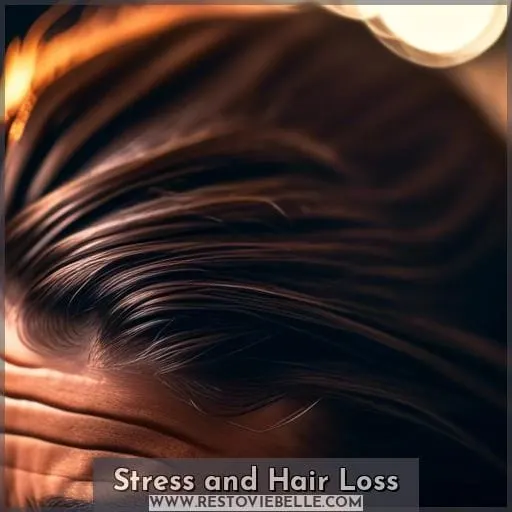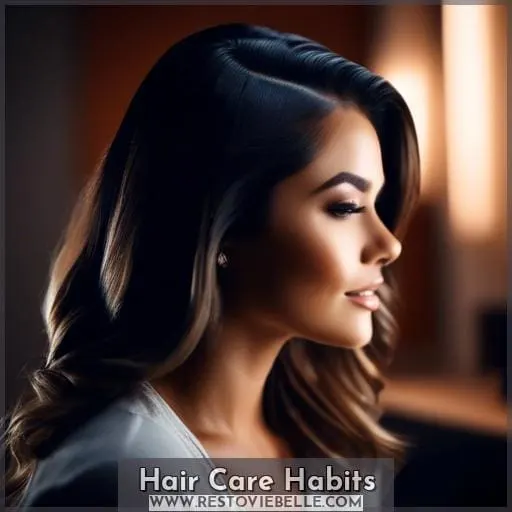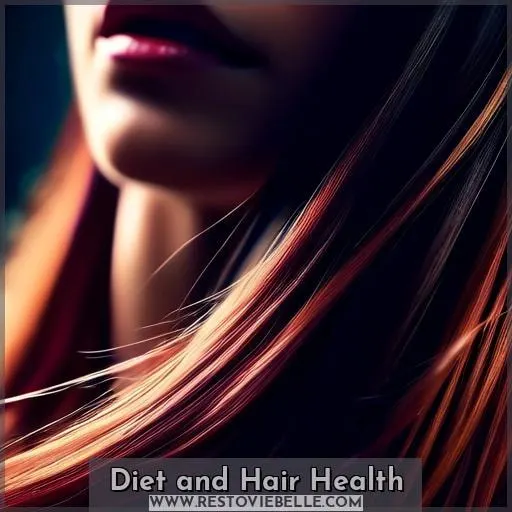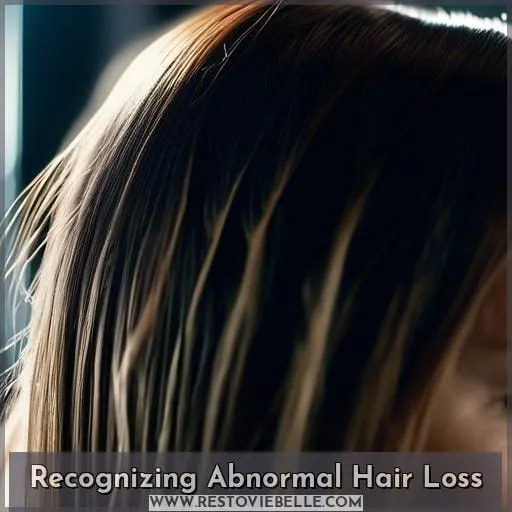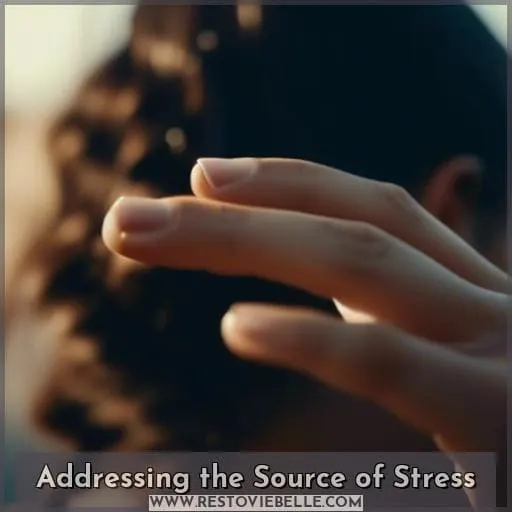This site is supported by our readers. We may earn a commission, at no cost to you, if you purchase through links.
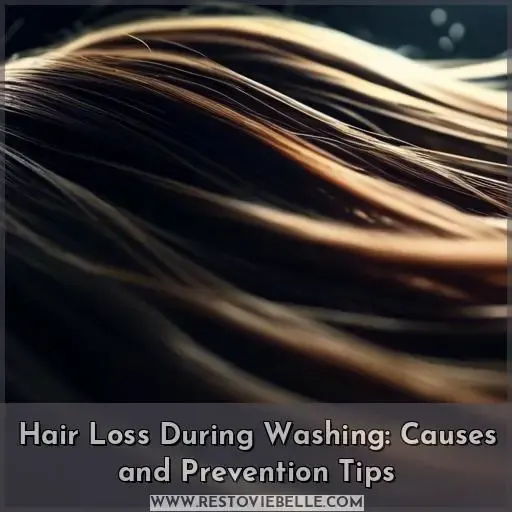 Taking a shower is a soothing experience, but finding hair strands on the floor can be distressing.
Taking a shower is a soothing experience, but finding hair strands on the floor can be distressing.
In this article about ‘Hair Loss During Washing: Causes and Prevention Tips,’ discover why your hair falls out when you wash it and how to reduce hair fall.
Learn about the impact of shampooing, water temperature, stress, hair care habits, diet, and more to prevent excessive shedding and maintain healthy hair.
No, washing your hair does not cause it to fall out; hair loss during washing is typically due to the natural shedding process or using harsh products.
Table Of Contents
- Key Takeaways
- Understanding Hair Shedding
- Causes of Shower Hair Loss
- Stress and Hair Loss
- Hair Care Habits
- Preventing Breakage
- Diet and Hair Health
- Reducing Shedding in the Shower
- Recognizing Abnormal Hair Loss
- Addressing the Source of Stress
- Frequently Asked Questions (FAQs)
- How does the water quality in my area affect hair loss during showering?
- Can the change of seasons or weather conditions influence the amount of hair I lose in the shower?
- How do hormonal changes, such as those during pregnancy or menopause, specifically impact hair shedding in the shower?
- Is there a difference in shower hair loss between natural hair types (curly, straight, wavy) and chemically treated or colored hair?
- Can certain water temperatures during showering exacerbate hair loss, and if so, what temperature is recommended to minimize shedding?
- Conclusion
Key Takeaways
- It’s normal to shed between 50 and 100 hairs a day, but excessive shedding, known as telogen effluvium, can occur due to stressors such as significant weight loss, childbirth, illness, or stress.
- Hair loss in the shower can be influenced by factors like the dislodging of hairs in the resting phase during shampooing, scalp sensitivity, the use of hot water, and harsh hair care products.
- A balanced diet rich in essential vitamins and minerals, including protein, biotin, and vitamins B12 and D, plays a crucial role in promoting healthy hair growth and preventing hair loss.
- To reduce hair shedding in the shower, it’s recommended to brush hair before showering, use a wide-toothed comb for detangling, avoid harsh chemicals and excessive heat, and consult a doctor for persistent or unusual hair loss.
Understanding Hair Shedding
When you notice hair falling out during your shower, it’s often due to the natural hair growth cycle. You’re not alone if you’re concerned about shedding; it’s normal for most people to lose between 50 to 100 hairs a day.
Understanding the difference between normal shedding and excessive hair loss can help you determine if what you’re experiencing is a typical part of hair renewal or if it’s time to seek advice from a healthcare professional.
Hair Growth Phases
Understanding your hair’s growth cycle is key to recognizing normal shedding versus hair loss.
Your hair goes through three main phases:
- The Anagen phase, where 85-90% of hair actively grows.
- The Catagen phase, a transitional stage where growth slows and the hair prepares to shed.
- The Telogen phase, where 5-10% of hair rests before eventually falling out.
It’s normal to shed about 100 hairs daily due to this cycle. However, factors like stress can trigger telogen effluvium, increasing the number of hairs in the resting phase, leading to more noticeable shedding, especially during hair washing.
To prevent hair fall, it’s important to manage stress, maintain a healthy diet, and be gentle with your hair care routine. If you experience unusual hair loss, such as patchy or rapid shedding, it’s wise to consult a doctor.
Normal Vs. Excessive Shedding
You might find it normal to see hair in the drain after showering, but it’s important to distinguish between typical hair shedding and excessive hair loss.
On average, losing up to 100 strands a day is considered normal due to the natural hair growth cycle. However, if you’re noticing more hair fall than usual, it could be a sign of excessive shedding.
Factors like hair texture, hair porosity, water hardness, and scalp sensitivity can impact hair shedding. If you’re wondering, Why does my hair fall out when I wash it? consider your shower frequency and hair care routine.
Excessive hair loss could be due to harsh products leading to hair breakage or other underlying issues. To manage shedding, tailor your hair care to your needs, and if you’re concerned about abnormal hair loss, consult a healthcare professional.
Causes of Shower Hair Loss
When you wash your hair, you might notice some strands falling out, which can be concerning. It’s important to understand that this is often a normal part of the hair growth cycle, particularly as the scalp is stimulated during shampooing and conditioning.
However, the temperature of the water you use can also impact your hair’s health; for instance, hot water can strip the scalp of natural oils, potentially leading to dryness and irritation.
If you’re seeing an unusual amount of hair loss during your showers, it could be a sign of a condition like telogen effluvium or a reaction to harsh hair care products.
Shampooing and Scalp Stimulation
When you’re in the shower, you might notice more hair fall, especially when shampooing. This is because the act of massaging shampoo into your scalp can dislodge hairs that are already in the resting or shedding phases of the hair growth cycle.
If you’re experiencing scalp sensitivity, conditions like scalp psoriasis, dandruff, or scalp eczema could be contributing factors. These conditions can cause inflammation and irritation, leading to discomfort and potentially increased hair fall.
To manage this, consider using hair fall shampoos designed to be gentle and to help control hair fall. Look for products that soothe scalp irritation and provide hair fall solutions without exacerbating scalp conditions.
Impact of Water Temperature
Continuing from the benefits of a gentle shampoo massage, let’s consider the role of water temperature on your hair’s health. The temperature of your shower water can significantly impact your scalp and hair texture.
- Hot Water: While it may help in opening up hair follicles for a thorough cleanse, too much heat can strip your hair of essential oils, leading to dryness and potential hair fall.
- Cold Water: A cooler rinse can seal hair cuticles, locking in moisture and reducing frizz. However, it mightn’t be as effective in removing all the dirt and oil from your scalp.
- Lukewarm Water: Often the best compromise, lukewarm water allows for effective cleansing without causing excessive hair damage or scalp sensitivity.
Stress and Hair Loss
When you notice more hair falling out during your shower, it’s understandable to feel concerned. However, it’s important to know that stress can significantly impact your hair health, leading to a condition known as telogen effluvium.
This temporary hair loss occurs when a larger number of hairs than usual enter the resting phase and shed, often as a response to physical or emotional stress.
The good news is that this type of hair loss is usually reversible, with hair often regrowing on its own once the stressor is removed.
Telogen Effluvium Explained
Telogen effluvium is a condition where you might notice more hair falling out, especially during stressful times. This happens because stress, whether it’s emotional or physical, can push more hairs into the telogen phase, which is the resting phase of the hair growth cycle.
Normally, only a small percentage of your hair is in this phase, but with telogen effluvium, that number increases, leading to more noticeable hair loss. The good news is, this type of hair fall isn’t permanent. Your hair can start to regrow once the stress is managed.
Finding effective hair fall solutions and remedies is crucial, not just for your hair’s health but for your overall well-being. Remember, it’s okay to seek help if you’re dealing with hair fall problems due to stress.
Stress Management Techniques
Continuing from the discussion on telogen effluvium, managing stress is crucial to combat hair loss.
Stress management techniques like yoga and meditation can be powerful tools. Engaging in regular exercise and relaxation techniques also helps reduce stress levels. These practices not only improve your overall well-being but can also aid in hair fall treatment.
Incorporating hair fall yoga or hair fall meditation into your daily routine can be therapeutic. Remember, finding the right hair fall therapy that resonates with you is key to managing stress effectively.
Hair Care Habits
When it comes to hair care, the way you wash your hair plays a crucial role in managing hair fall. Choosing the right shampoo for your hair type and employing gentle washing techniques can make a significant difference.
It’s essential to select a shampoo that matches your hair and scalp needs, and to wash your hair with care to avoid unnecessary stress on your follicles.
Choosing the Right Shampoo
Choosing the right shampoo is crucial for managing stress-related hair loss and ensuring the health of your hair.
When selecting a shampoo, consider your hair type and scalp condition. Opt for sulfate-free shampoos if you have sensitive or dry hair, as they’re gentler and less likely to strip natural oils from your scalp.
Natural shampoos, enriched with ingredients like aloe vera, tea tree oil, or argan oil, can also soothe the scalp and promote hair health.
For those experiencing hair fall, look for products specifically labeled as hair fall shampoos, conditioners, masks, or serums, which are formulated to strengthen hair and reduce shedding.
Gentle Hair Washing Techniques
When washing your hair, it’s crucial to adopt gentle techniques to prevent hair fall.
Start by adjusting the water temperature; lukewarm is ideal to avoid damaging your hair texture.
As you shampoo, avoid using your fingernails—this can irritate your scalp. Instead, opt for a soothing scalp massage with your fingertips to stimulate hair follicles.
Be mindful of your shampoo frequency; over-washing can strip hair of essential oils, while under-washing can lead to buildup.
After shampooing, apply hair fall oils, supplements, vitamins, and minerals to nourish your scalp and strands.
Preventing Breakage
When you notice your hair falling out during washing, it’s crucial to consider the products you’re using and how you handle your hair.
Harsh chemicals and excessive heat can weaken your strands, leading to breakage.
To protect your hair, opt for gentle, nourishing products and minimize the use of heat styling tools.
Avoiding Harsh Products
Avoiding harsh products is key to preventing hair breakage and maintaining healthy hair.
- Opt for sulfate-free shampoos to keep your hair’s natural oils intact and reduce the risk of irritation and dryness.
- Incorporate natural oils like coconut or argan into your routine, which can lock in moisture and strengthen your hair.
- Choose silicone-free conditioners and consider hair masks to deeply nourish and repair damaged strands.
Minimizing Heat Damage
To minimize heat damage and prevent hair breakage, it’s crucial to adopt a gentle approach to drying and styling your hair. Instead of relying solely on high-heat tools, consider incorporating air drying into your routine.
This method not only reduces the risk of heat damage but also preserves the natural moisture of your hair, leading to healthier, stronger locks. When using a blow dryer, opt for a cooler setting and avoid directing the heat too closely to your roots or any single spot for an extended period.
This helps maintain your hair’s hydration and prevents excessive dryness and damage.
Applying a heat protectant before styling is another essential step. These products form a protective barrier around the hair shaft, shielding it from the damaging effects of high temperatures. Whether you’re blow drying, curling, or straightening, a heat protectant can significantly reduce the risk of breakage and maintain the integrity of your hair.
For those who’ve undergone a hair transplant or are experiencing hair fall, taking these precautions is even more critical. Gentle drying and styling methods, along with the use of heat protectants, can aid in the recovery process and help ensure the longevity of your hair restoration results.
Diet and Hair Health
When it comes to maintaining the health of your hair, your diet plays a crucial role. Ensuring you’re getting enough essential vitamins and minerals can significantly impact your hair’s strength and hydration.
Incorporating a variety of fruits and vegetables into your meals can provide your body with the nutrients it needs to support healthy hair growth, making it less likely for your hair to fall out during washing.
Essential Vitamins and Minerals
After discussing how to prevent hair breakage, it’s crucial to understand the role of diet in maintaining healthy hair. Your hair’s health can be significantly influenced by what you eat, as certain nutrients are vital for hair growth and strength.
- Nutritional Deficiencies: A lack of essential vitamins and minerals can lead to hair loss. Ensure your diet includes a variety of nutrients to support hair health.
- Hair Growth Supplements: Supplements like biotin can be beneficial, especially if you have a deficiency. Biotin benefits include strengthening hair, but always consult a healthcare professional before starting any supplement.
- Vitamin B12 Intake: Adequate vitamin B12 intake is crucial for healthy hair. A deficiency mightn’t only affect hair growth but also lead to other health issues.
Incorporating a balanced diet rich in vitamins and minerals can help combat hair loss. If you’re experiencing significant hair fall, consider exercises to reduce stress, and consult a doctor before considering hair fall surgery or other treatments.
Remember, while genetics play a role, a nutritious diet is a key factor in maintaining healthy hair.
Hydration and Hair Strength
Just as vitamins and minerals are crucial for your body, hydration plays a pivotal role in maintaining the strength and health of your hair.
Proper hydration impacts your hair’s porosity, which is its ability to absorb and retain moisture. This, in turn, affects the elasticity, protein balance, and moisture levels of your hair.
When your hair is well-hydrated, it’s more resilient and less prone to breakage. Ensuring your hair has the right balance of moisture and protein is key to maintaining its elasticity and preventing damage.
So, remember to drink plenty of water and use hair care products that support hydration to keep your hair strong and healthy.
Reducing Shedding in the Shower
When it comes to reducing hair shedding in the shower, a few simple changes can make a big difference.
Brushing your hair before stepping into the shower can help remove loose strands, minimizing the amount you’ll see going down the drain.
Once your hair is wet, opt for a wide-toothed comb to detangle gently, reducing breakage and further shedding.
These steps not only help in managing the amount of hair you lose during a shower but also contribute to the overall health of your hair by preventing unnecessary stress on your strands.
Brushing Before Showering
Brushing your hair before showering can significantly reduce shedding in the shower. Tailor your brushing technique to your hair type and scalp sensitivity to avoid irritation.
If you have a sensitive scalp, be gentle and use a brush compatible with your hair’s needs. Adjust your shampoo frequency according to how your hair and scalp respond, and always choose products that work well with your hair type.
This proactive approach helps minimize hair loss and keeps your locks looking their best.
Using a Wide-toothed Comb
When you’re fresh out of the shower, reach for a wide-toothed comb to tackle any tangles. This tool is your ally in damage prevention, gliding through wet locks with ease and minimizing breakage.
Gentle brushing with a wide-toothed comb not only detangles but also protects your hair’s integrity, especially when it’s most vulnerable.
Recognizing Abnormal Hair Loss
When you notice more hair falling out during your shower, it’s natural to worry. However, it’s crucial to distinguish between normal shedding and signs of abnormal hair loss.
If you’re seeing clumps of hair or a noticeable thinning across your scalp, it might be time to consult a doctor. These symptoms could indicate an underlying condition that requires professional attention.
Signs of Pattern Baldness
If you’re noticing hair thinning or a receding hairline forming an M shape, it’s time to pay attention. These signs could point to pattern baldness, a condition often influenced by genetic factors.
Early detection is key to managing this type of hair loss. Don’t overlook nutritional deficiencies; they can exacerbate the issue. Home remedies and scalp treatments may offer some relief, but understanding the root cause is crucial.
If you’re seeing these changes, consider consulting a healthcare professional for advice on treatment options.
When to See a Doctor
When you notice your hair falling out at an increased rate or developing patchy hair loss, it’s time to consult a doctor.
Experiencing skin irritation and pain alongside hair loss could indicate underlying causes that require medical attention.
Don’t wait if you can’t pinpoint a reason for the hair loss or if other symptoms accompany it.
Seeking professional help early can provide insights into your condition and guide you towards appropriate treatments or lifestyle adjustments to manage or reverse the issue.
Addressing the Source of Stress
If you’re noticing more hair loss during your showers, it’s important to consider that stress might be playing a role.
Stress can lead to a condition known as telogen effluvium, which causes more hairs to enter the resting phase and fall out more easily.
To address this, you can start by finding ways to relax and reduce stress in your life, such as getting more sleep, exercising, or meditating.
Lifestyle Changes
If you’re noticing more hair in the drain, it’s time to consider lifestyle changes to address stress, which can be a significant factor in hair loss.
Stress management techniques like meditation, regular exercise, and ensuring adequate sleep can help reduce stress levels.
Additionally, diet changes that include a variety of fruits, vegetables, and proteins can provide essential nutrients for hair health.
Incorporating scalp massage into your hair care routine can also promote relaxation and potentially improve hair growth.
Pre-shampoo conditioning might help in reducing hair breakage, further minimizing hair loss.
Seeking Professional Support
If you’re grappling with stress-related hair loss, it’s crucial to seek professional support. Therapy options, such as counseling, can offer immense benefits, helping you navigate the emotional toll of hair loss.
Support groups provide a community of individuals facing similar challenges, fostering a sense of belonging and understanding. Finding a therapist who specializes in stress management can be a game-changer, equipping you with strategies to cope more effectively.
Additionally, stress management apps are readily available to provide guidance and tools for relaxation and emotional well-being right at your fingertips.
Frequently Asked Questions (FAQs)
How does the water quality in my area affect hair loss during showering?
Hard water, high in minerals like calcium and magnesium, can leave residue on your hair and scalp.
Consider a water softener or filter to mitigate these effects.
Can the change of seasons or weather conditions influence the amount of hair I lose in the shower?
Yes, the change of seasons or weather conditions can indeed influence the amount of hair you lose in the shower.
Seasonal hair loss, particularly during transitions into fall and spring, is attributed to changes in temperature and daylight hours affecting your hair’s growth cycle. This phenomenon is more noticeable in these periods due to the natural shedding phase of the hair cycle aligning with these seasons.
While it’s normal to shed 50 to 100 strands daily, you might observe an increase during these times.
How do hormonal changes, such as those during pregnancy or menopause, specifically impact hair shedding in the shower?
Hormonal changes during pregnancy and menopause significantly impact hair shedding.
During pregnancy, elevated estrogen levels often lead to fuller, thicker hair. However, postpartum, hormone levels drop, leading to increased shedding, a phase known as postpartum hair loss.
Menopause brings a decrease in estrogen and progesterone, making hair grow slower and thinner. This hormonal imbalance can also increase androgens, causing hair follicles to shrink and hair to fall out more easily, especially during washing.
To manage, gentle hair care and addressing nutritional needs are key.
Is there a difference in shower hair loss between natural hair types (curly, straight, wavy) and chemically treated or colored hair?
Chemically treated or colored hair is more prone to becoming high porosity due to damage from treatments, making it more vulnerable to breakage during washing.
Natural hair types vary in porosity but aren’t inherently damaged by treatments, potentially influencing their resilience to shedding in the shower.
Can certain water temperatures during showering exacerbate hair loss, and if so, what temperature is recommended to minimize shedding?
Diving into the steamy embrace of a hot shower can feel like a hug for your soul, but it’s a bit of a double-edged sword for your tresses.
Imagine your hair as a delicate flower under the summer sun; too much heat, and it wilts.
It’s like a gentle breeze on a spring day, offering enough warmth to cleanse effectively without stripping your hair of its natural defenses. So, next time you’re tuning the temperature, think of cradling your hair in a warm, not scorching, embrace to keep it thriving and minimize shedding.
Conclusion
Discovering that approximately one in three women with hair loss experience symptoms of depression highlights the profound impact hair health can have on our overall well-being.
It’s crucial to remember that while it’s normal to lose 50-100 hairs daily, the reasons behind why your hair falls out when you wash it can vary widely. From the natural shedding process to the effects of stress and the products we use, understanding these factors is key to managing and preventing unnecessary hair loss.
By adopting gentle hair care habits, choosing the right shampoo, and paying attention to our diet, we can significantly influence our hair’s health. Remember, addressing the root cause of stress and seeking professional support when needed can also make a significant difference.
Your journey to reducing hair fall in the shower and maintaining healthy hair is a holistic one, encompassing everything from the products you use to your lifestyle choices.
